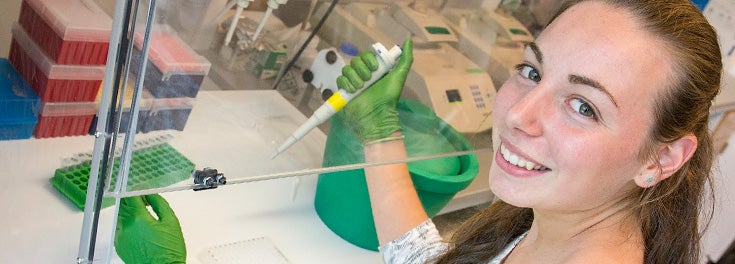 You could grab your bathing suit, sunglasses, and flip-flops for a summer at the University of Rhode Island—or you could choose a lab coat, goggles, or waders for a different kind of summer as a URI Summer Undergraduate Research Fellow (SURF), conducting research with top scientists on Alzheimer’s disease, liver disease, DNA repair mechanisms, or parasite tolerance in oysters, among other projects.
You could grab your bathing suit, sunglasses, and flip-flops for a summer at the University of Rhode Island—or you could choose a lab coat, goggles, or waders for a different kind of summer as a URI Summer Undergraduate Research Fellow (SURF), conducting research with top scientists on Alzheimer’s disease, liver disease, DNA repair mechanisms, or parasite tolerance in oysters, among other projects.
And when you complete your research, you’d join more than 100 other students, as well as faculty and administrators from nine colleges and universities in Rhode Island, to present your findings at the Summer Undergraduate Research Conference at URI. The fellowships and conference are sponsored each year by two, multi-million dollar federal programs based at URI—the Rhode Island IDeA Network of Biomedical Research Excellence (INBRE) and the Rhode Island Experimental Program to Stimulate Competitive Research (EPSCoR).
The program allows undergraduate students to work with research faculty and be paid a stipend. In some cases, the student-faculty collaborations work so well that they continue well beyond the 10-week SURF program. That’s the case with Rachel Carley, who will enter her third year in URI’s six-year doctor of pharmacy program this fall.
She spent the summer working with Assistant Professor of Biomedical and Pharmaceutical Sciences Nisanne Ghonem, and will continue to research a cholesterol drug’s role in reducing inflammation in the liver, which in turn reduces certain liver diseases. Working one-on-one with Ghonem in the lab, Carley proved that fenofibrate, known more commonly by the brand name Tricor, reduces inflammation, which untreated, can lead to fibrosis, cirrhosis, and end-stage liver disease or malignancies in the liver, bile duct or gallbladder.
“Coming from the pharmacy side, I want to know how drugs do what they do,” Carley said. “You are basically asking how does this happen and how do we come to understand this? This shows the real-world application of what we are learning in the classroom.”
Junior Rachael Renzi, a biological sciences major, spent the last 10 weeks conducting laboratory studies of disease tolerance among oysters, a project that she and her mentors hope will benefit Rhode Island’s thriving oyster aquaculture industry.
Working with postdoctoral researcher Tal Ben-Horin and U.S. Department of Agriculture scientist Dina Proestou, Renzi injected oysters with various concentrations of the parasite that causes Dermo, a common oyster pathogen, and collected oyster tissue samples from some of them at different times. She then extracted DNA from them, as well as from those that died, to determine the concentration of parasites each contained and to characterize how the disease proliferated through time.
“The hands-on work was the part of the program I found most appealing,” Renzi said. “I liked how every day was different, how you don’t really know what you’re going to get into until you’re in the middle of it. Processing data, reading results, and seeing how it all comes together was really cool to see.”
Senior Hannah Madison spent her summer elbow deep in seaweed at the Napatree Point lagoon in Westerly, R.I., assessing the seasonal variability of algae blooms and how it relates to water quality. Working with Professor Carol Thornber and postdoctoral researcher Lindsay Green, Madison conducted algae surveys, weighed and measured algae, and counted the marine invertebrates that live among it. She also assisted with similar work at a site in Greenwich Bay.
“It’s an extremely interesting experience,” said Madison, an ocean engineering major. “I definitely learned from the fellowship that I don’t want to be stuck in a cubicle,” she said. “I want to be out there in the field seeing what needs to be done and doing it. That was the best part of the project. We were never just sitting.”
